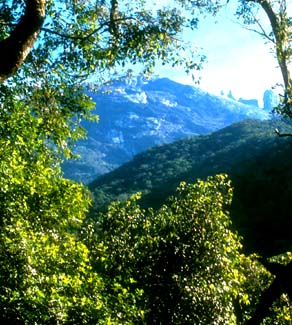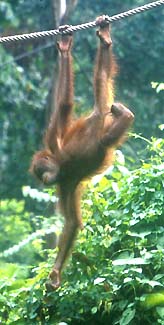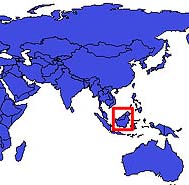

 |
This is a report of a month-long bird & mammal watching trip in
Borneo,
visiting the Malaysian states of Sabah & Sarawak. Highlights
included:
|
 |
Between 17 July-13 August 2003, we spent nearly a month (25 days) on Borneo. A brief list of our itinerary follows, and a map with a key to the primary locales of our visit. Some of these are quite well known to birders and naturalists: Mt. Kinabalu (the highest mountain between the Himalayas and New Guinea), Sepilok orangutan rehabilitation reserve near Sandakan, and Danum Valley. Don had visited Mt. Kinabalu and Danum Valley during ten days in August 1988. Other spots are just now beginning to be well-known, such as Sukau and its lodges on the Kinabatangan River, or the offshore islet of Pulau Tiga (famous recently as the filming locale for the first "Survivor" TV series). Mulu National Park in Sarawak is well off the usual birder trek, and therefore somewhat of an unknown adventure. Our visit was arranged by Kingfisher Tours who worked with us to create the itinerary we wanted. They arranged all the lodging and transportation (mostly by Borneo Ecotours) so our trip was essentially hassle free, yet it cost less than half of what a bird tour would cost. We flew from California to Singapore on United Airlines (both of us had enough free mileage for this round-trip!) and thereafter on Malaysian Airlines. Excluding our overnights in Singapore, the itinerary was:

Borneo is the largest island in the Greater Sundas. It is divided among three countries: Malaysia, which we visited, has two states (Sabah & Sarawak); Indonesia (southern two-thirds of island, known as Kalimantan); and the small sultanate of Brunei. On the closer map (right) the locales we visited are shown by red arrows. |
 |
Looking at trip reports on the web, it seems that most birders have visited Sabah in the spring, February-May. We printed out and took these trip reports with us:
We chose to visit Borneo in July-August because (a) it is easier for Rita, a teacher, to get time off in the summer and (b) it is the dry season so one is less likely to be hampered by the weather. We did not lose any days to the weather, but it clouded up and rained for several hours on most afternoons at Mt. Kinabalu, and also rained in the afternoon on several days in Danum Valley.
 |

Don visited Borneo on his own in 1988 but this was Rita's first trip. The bridge over the Segama River at Danum Valley Field Centre is unchanged in the last 15 years (above). And, as these shots show, Don also remains (mostly) unchanged: photo from 1988 (left; taken in Sumatra a week after Borneo) and photo from 2003 (right; Borneo Rainforest Lodge). |
 |
 One
thing that has very much changed since 1988 is the literature available.
Now there are good field guides for birds, mammals, and many herps. For
birds,
MacKinnon & Phillipps (1993; shown in the photo) is perfectly adequate
and a major improvement over the Smythies' pocket guide (Francis 1984)
that I used in 1988. This new field guide does not match the level of detail
or the current expertise shown in other recent field guides to tropical
countries (e.g., the new guides for Uganda, Ecuador, Venezuela, etc.),
and was little help for female sunbirds and other difficult problems, but
is just fine for the wide majority of birds encountered. For mammals,
the field guide by Payne, Francis & Phillipps (1985) had come out just
in time for the 1988 trip and remains the standard today. For herps,
I acquired Stuebing & Inger (1999) which was quite good and has spectacular
color photos of many (but not all) snakes on the island, and Inger &
Lian (1996) for an overview of the common reptiles & amphibians, again
with good color photos of many species. All of these books can be acquired
at a book store in the shopping center next door to the Hyatt hotel in
downtown Kota Kinabalu, and we saw many of them for sale elsewhere, including
the airport. I presume they can all be acquired via the Internet as well.
I was also interested in the pitcher plants on Mt. Kinabalu, and
bought the last copy of Kurata (1976) at the bookshop at Mt. Kinabalu headquarters. One
thing that has very much changed since 1988 is the literature available.
Now there are good field guides for birds, mammals, and many herps. For
birds,
MacKinnon & Phillipps (1993; shown in the photo) is perfectly adequate
and a major improvement over the Smythies' pocket guide (Francis 1984)
that I used in 1988. This new field guide does not match the level of detail
or the current expertise shown in other recent field guides to tropical
countries (e.g., the new guides for Uganda, Ecuador, Venezuela, etc.),
and was little help for female sunbirds and other difficult problems, but
is just fine for the wide majority of birds encountered. For mammals,
the field guide by Payne, Francis & Phillipps (1985) had come out just
in time for the 1988 trip and remains the standard today. For herps,
I acquired Stuebing & Inger (1999) which was quite good and has spectacular
color photos of many (but not all) snakes on the island, and Inger &
Lian (1996) for an overview of the common reptiles & amphibians, again
with good color photos of many species. All of these books can be acquired
at a book store in the shopping center next door to the Hyatt hotel in
downtown Kota Kinabalu, and we saw many of them for sale elsewhere, including
the airport. I presume they can all be acquired via the Internet as well.
I was also interested in the pitcher plants on Mt. Kinabalu, and
bought the last copy of Kurata (1976) at the bookshop at Mt. Kinabalu headquarters.
We also profited from reviewing specialized texts on pittas and broadbills (Lambert & Woodcock 1996) and swiftlets (Chantler 2000), and papers on bulbuls and babblers (Dutson et al. 1991), Kinabalu Friendly Warbler (Harrap 1994), and Bristlehead (Colenutt 2002). Besides the on-line trip reports, good overviews of the birding locales are in Bransbury (1993) and Wheatley (1996), and the Oriental Bird Club published a pamphlet in 1994 on birding sites in Malaysia that was very useful. Showler (1992) published a good summary of birding opportunities at Danum Valley Field Centre. We enjoyed reading John MacKinnon's (1974) account of his initial research on Orangutans in Danum Valley (before it was a reserve), including his accounts of the natural history there. In addition to the literature, I had a Sony Minidisc recorder with a Senheiser shotgun mike, allowing "trolling" for birds with the disc or tape-record & playback for unknown vocalizations. I had created my own custom disc of Bornean specialties from cassette tapes by Steve Whitehouse (2000), another by Frogmouth Publ. out of U.K. (1994), and some southeast Asia tapes put out by the British Library of Sounds (I'm told they now have a newer, upgraded CD). In any event, I had a custom tape with all the broadbills together, all the pittas together, etc. We really did not do that much taping but it was invaluable (a) in Mulu when trying to learn the birds on the first few days and (b) to tape in selected species. We would have missed some important birds without the tape (e.g., Whitehead's Broadbill & Kinabalu Friendly Warbler on Mt. Kinabalu; Banded Broadbill at Sukau; Blue-headed Pitta at Borneo Rainforest Lodge. At the latter site, however, our guide (Wangkong Intal) whistled in the other pittas for us without use of tapes. |
 Other
things that have changed recently are the amenities offered. There are
now canopy walkways at Borneo Rainforest Lodge (right) and at Poring Hot
Springs. The BRL walkway is excellent and feels reasonably safe, and it
can be birdy at times. The one at Poring Hot Springs is much less sturdy;
is often full of noisy tourists; and we saw zero (0) birds from it. It
also costs $5 each and is thus a complete waste of money. There are also
new observation towers at Danum Valley Field Centre and Sepilok Forest
Reserve. We spent two hours on the latter one without seeing much but others
have had some success. All these walkways and towers do give a different
perspective as one is well up in the canopy. Other
things that have changed recently are the amenities offered. There are
now canopy walkways at Borneo Rainforest Lodge (right) and at Poring Hot
Springs. The BRL walkway is excellent and feels reasonably safe, and it
can be birdy at times. The one at Poring Hot Springs is much less sturdy;
is often full of noisy tourists; and we saw zero (0) birds from it. It
also costs $5 each and is thus a complete waste of money. There are also
new observation towers at Danum Valley Field Centre and Sepilok Forest
Reserve. We spent two hours on the latter one without seeing much but others
have had some success. All these walkways and towers do give a different
perspective as one is well up in the canopy.
Something that hasn't changed is the presence of leeches in the Sabah lowlands, particularly at Sepilok and Danum Valley. Note the stylish leech socks that Rita is wearing. They were effective for her and she got zero (0) bites. Don was less lucky and was bitten thrice, twice on his arms by Tiger Leech Haemadipsa picta. Unlike the painless bite of Brown Leech H. zeylandica, the bite of picta is painful and can (and did) become infected. Tiger Leeches are up in the low trees and bushes and drop onto the victim as he or she brushes by, unlike Brown Leeches which are on the forest floor and quickly inch-worm their way to feet and ankles. Rita made her own leech socks before the trip, but commercial ones are available for purchase ($12) at Borneo Rainforest Lodge. |
Fifteen years ago the rutted road to Danum Valley went through hour after hour of clearcut tropical forest, a moonscape of utter devastation. Now, secondary forest has filled in much of the roadside but the logging continues out-of-view. On the 2.5 to 3 hour drives in and out of Danum Valley, one either passes or is stuck behind huge logging trucks full of huge trunks of tropical trees. The trucks stir up clouds of dust on the winding road and make the drives miserable; they also tear up the roads badly. Between Sandakan and Lahad Datu, one travels on nice paved roads through miles and miles of planted monoculture oil palms. When you turn off to go to Gomantong Cave and Sukau, the road become very badly rutted dirt and must be nearly impassable in wet weather. It is a bone-jarring experience. So much of lowland Borneo has been lost (see range maps for Bornean pittas, for example, in Lambert & Woodcock 1996; they map habitat for each species, and so much is gone). Yet, when you finally reach Danum Valley or the Kinabatangan River, the habitat is gorgeous. What is left of Borneo is very impressive. Support ecotourism to keep what remains pristine!
The links below go to pages with a detailed daily log and a complete trip list. Each page includes many photographs.
|
DAILY LOG for the July-August 2003 TRIP |
|
covering birds & mammals & some herps |
PHOTOS: All photos on this page are © 2003 Don Roberson; all rights reserved. Many other shots from this trip are scattered about this web site. Check particularly bird families, mammals, and herps listings.
Literature cited:
Bransbury, J. 1993. A Birdwatcher's Guide to Malaysia. Waymark Publ., Adelaide, Australia.TOPChantler, P. 2000. Swifts: A Guide to the Swifts and Treeswifts of the World. 2d ed. Yale Univ. Press, New Haven, CT.
Colenutt, S. 2002. Little-known Oriental bird: Bornean Bristlehead. Oriental Bird Club Bull. 35:75-77.
Dutson, G., R. Wilkinson, and B. Sheldon. 1991. Hook-billed Bulbul Setornis criniger and Grey-breasted Babbler Malacopteron albogulare at Barita Ulu, Kalimantan. Forktail 6:78-82.
Francis, C.M., ed. 1984. Pocket Guide to the Birds of Borneo, from plates in B.E. Smythies, Birds of Borneo, 3d ed. The Sabah Society, Kota Kinabalu.
Harrap, S. 1994. Little-known Oriental bird: Kinabalu Friendly Warbler. Oriental Bird Club Bull. 20:24-27.
Inger, R.F., and T.F. Lian. 1996. The Natural History of Amphibians and Reptiles in Sabah. Natural Hist. Publ. (Borneo) Sdn. Bhd., Kota Kinabalu.
Kurata, S. 1976. Nepenthes of Mount Kinabalu. Sabah National Parks publ. 2, Kota Kinabalu.
Lambert, F., and M. Woodcock. 1996. Pittas, Broadbills, and Asities. Pica Press, East Sussex, U.K.
MacKinnon, J. 1974. In Search of the Red Ape. Holt, Rinehart & Winston, New York.
MacKinnon, J., and K. Phillipps. 1993. A Field Guide to the Birds of Borneo, Sumatra, Java, and Bali. Oxford Univ. Press, Oxford.
Payne, J., C.M. Francis, and K. Phillipps. 1985. A Field Guide to the Mammals of Borneo. The Sabah Society, Kota Kinabalu.
Showler, D.A. 1992. Birdwatching areas: Danum Valley Conservation Area, Sabah, Malaysia. Oriental Bird Club Bull. 16:26-31.
Steubing, R.B., and R.F. Inger. 1999. A Field Guide to the Snakes of Borneo. Natural Hist. Publ. (Borneo) Sdn. Bhd., Kota Kinabalu.
Wheatley, N. 1996. Where to Watch Birds in Asia. Princeton Univ. Press, Princeton, N.J.
GO TO LIST OF BIRD FAMILIES OF THE WORLD